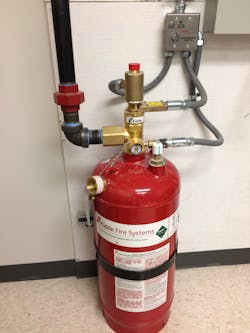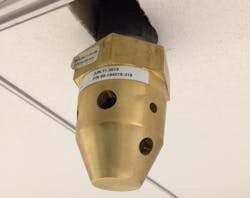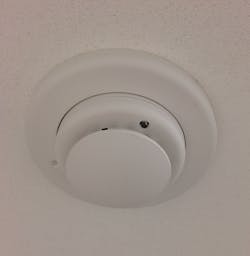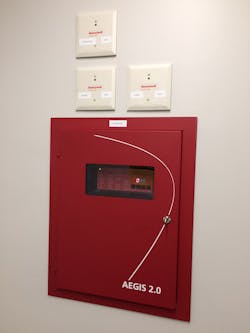What Firefighters Need to Know About Clean Agent Systems
Clean agent systems are waterless systems that protect property that’s found in specific occupancies, such as data centers/storage, document storage, imaging suites and telecommunication centers. The systems use an inert gas to extinguish a fire that would be obstructed from a standard sprinkler and reduce damage from smoke and water. Clean agent systems are regulated by NFPA 2001: Standard on Clean Agent Fire Extinguishing Systems and are defined as an “electrically nonconducting, volatile or gaseous fire extinguishant that does not leave a residue upon evaporation.”
There are various clean agents. FM-200 and FE-25 have zero ozone-depletion potential but have high global warming and atmospheric lifetimes. Halon is a legacy agent that no longer is installed because of ozone-depleting qualities. Novec 1230 has a very low global warming potential and a short atmospheric lifetime. Inergen and Argonnite have zero ozone-depletion potential and no global warming and atmospheric lifetime.
Each clean agent has pros and cons that are based on the hazard that’s protected, environmental impact, the cleanup that’s required after a discharge and human contact.
Clean agents suppress fires in three ways:
- Inert agents deplete the oxygen
- FM-200/FE-25 absorb heat and disrupt the combustion reaction
- Novec 1230 absorbs heat
How they work
Clean agent systems are, essentially, an extinguisher that automatically discharges. The source of the system is a high-pressure storage cylinder (Figure 1) that’s piped to nozzles (Figure 2) that discharge the agent. Piping is installed symmetrically to achieve equal discharge pressure and a balanced dispersion. Smoke detectors (Figure 3) are provided to recognize a fire and initiate discharge. A horn/strobe unit (Figure 4) is placed inside of the room above the door to alert occupants to system activation, and a strobe is provided outside of the room above the door to indicate that a discharge occurred. An abort/manual pull station (Figure 5) is located inside of the room adjacent to the door and a keyed maintenance switch is provided outside of the room to take the system out of service. All of these items are wired to a control panel (Figure 6) that typically is located outside of the space that’s adjacent to the door. Signs provide identification of the various appurtenances and explain the audio/visual device warnings.
Once the time-delay sequence is complete, the agent is discharged and the strobe that’s outside of the room activates. The abort switch may be used to stop the agent discharge during the delay sequence. The manual release starts the sequence as if the second detector was initiated and overrides the abort switch or it will activate an immediate discharge of the agent. The keyed maintenance switch can be used to prevent the system from discharging, but the detection system will remain active.
Fire code doesn’t allow a clean agent system to be the only defense against a fire, because it’s a finite source. The cylinder discharges the agent until it’s empty. If the fire isn’t controlled, the fire will continue to develop, so an automatic sprinkler system is required as backup. There are exceptions to this rule, but they require approval from the local fire code official. Pre-action systems usually are provided, because they are well-suited to critical spaces, too.
Try to determine whether the pre-action system discharged if one is present. If the clean agent hasn’t contained the fire and you’re making entry, be prepared for sprinklers to activate. Enter the space wearing SCBA. The agent isn’t toxic, but you’re in there because of a fire, so protect yourself as you would in the case of any other fire. Locate the source of the event and determine whether the fire was extinguished. If it wasn’t, complete the extinguishment with an extinguisher or handline. Firefighters must be cognizant of the methods that are used at this point. The extinguisher must be compatible with the hazard in the room to work adequately. The incorrect choice or the use a handline could create more damage to contents.
Once the fire is placed under control, the room will need to be restored to operation as quickly as possible. This probably won’t be the responsibility of the fire department, but you might be asked to assist. If ventilation of the space cannot be performed by facilities personnel by manipulating the building HVAC system, you might be required to use fans. Many modern buildings have fixed sash windows that can’t be opened for ventilation, which complicates the task. Even if you ventilate the space into the surrounding areas there won’t be a problem. The agents are nontoxic and work at small concentrations within a confined space, so there’s no risk to occupants. However, firefighters should be prepared to explain this to put occupants’ minds at rest.
Low-frequency, high-consequence events
Clean agent systems are a complex network of fire suppression components that are used to protect critical contents or spaces. Discharges are low-frequency, high-consequence events. Even a minor fire in this type of space can be a major event to a building owner.
Firefighters must understand these systems to be safe and to mitigate the situation in a timely manner while protecting the space and its contents. There might be items that are irreplaceable or equipment that’s critical to business operations, which will need to be brought back online quickly.
Identify areas with clean agent during the plan review process. Once the system is installed, attend the commissioning process. That is the best time to coordinate with everyone. The engineer and installer will be there to discuss the system operation, the building owner will be there to discuss the contents and nature of the space, and the facilities personnel will be there to discuss your response efforts.
There are many ways that clean agent systems can function. This article only describes what I believe is most commonly installed. Firefighters must ensure that they have an accurate understanding of the systems that are in their response area.
About the Author
E.J. Henninger
E.J. Henninger is captain at the Gilbertsville, PA, Fire and Rescue Company and a senior project designer at Genesis Engineers in southeastern Pennsylvania. He is the mission leader for Building Firefighter Development, which is a project to educate the fire service about building systems from an engineering perspective. Henninger is also a member of the International Association of Fire Chiefs and actively supports the fight against cancer.



